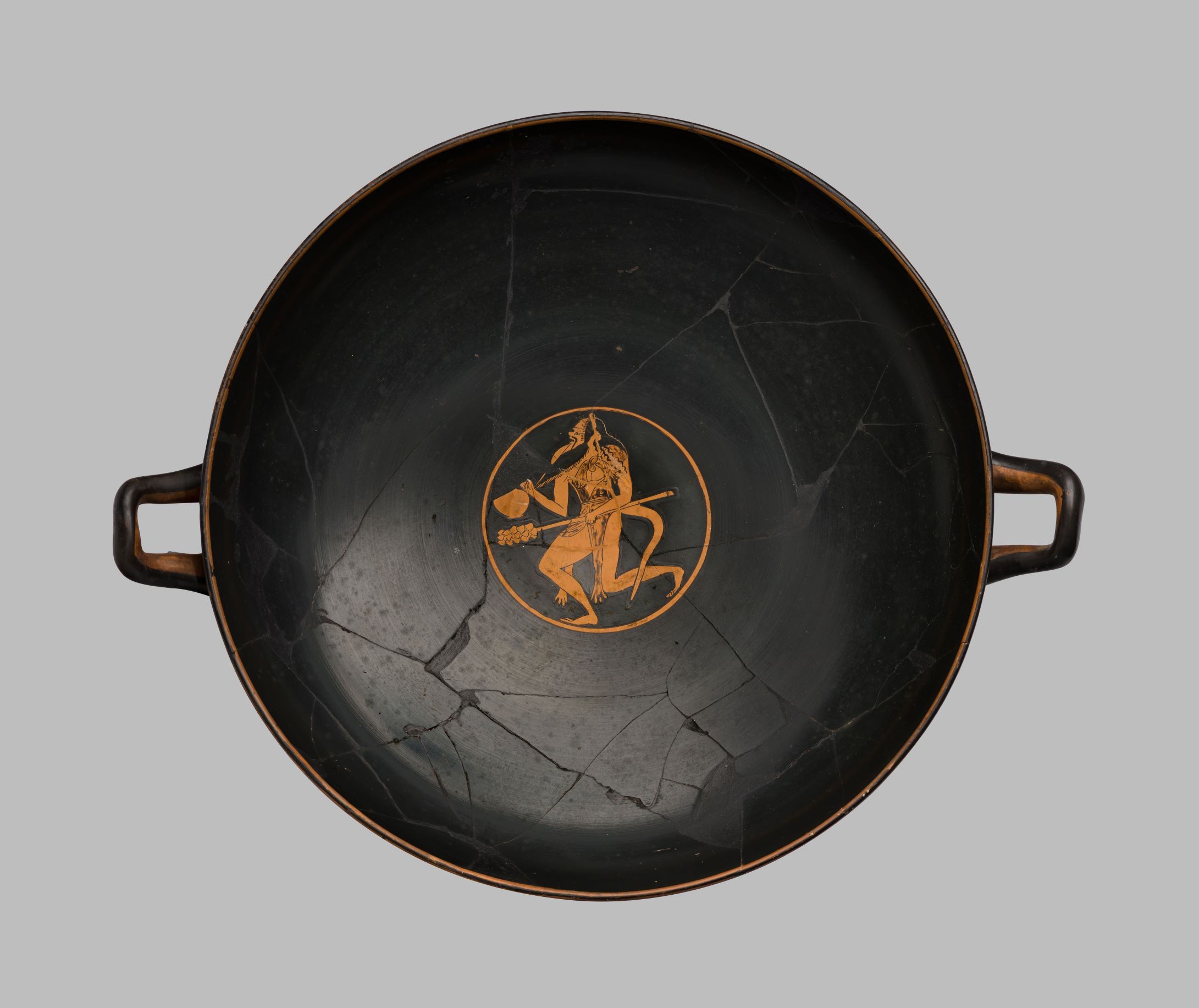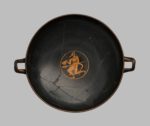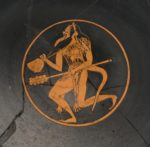
Eye Cup [Gr18]
Athenian Red-Figure, by the Winchester Painter, 520-500 BC
Painted terracotta (h. 13.3 cm, w. 41.3 cm), mended with small restorations
Interior: Satyr holding thyrsus and wineskin. Exterior: Naked athletes exercising with halteres (jumping weights).
This large kylix (drinking cup) is an early example of the red-figure technique, developed by Athenian vase painters around 530 BC. Instead of painting black figures against the red clay, artists began to leave figures in the natural colour of the clay, painting the rest of the vase black. Rather than being incised, detail was painted with a fine brush. The new red-figure technique had several advantages: it gave the impression of a third dimension and allowed the more realistic depiction of bodies in motion.
Like many drinking cups, the decoration of this vase is appropriate to the themes of the symposium, a drinking party for upper-class Athenians. In the centre of the bowl is a satyr, a mythological figure half man and half goat, who was associated with Dionysus, the god of wine. He holds a wine jug and thyrsus, a staff carried by worshippers of the god, decorated at the top with ivy leaves. Diluted paint is used for the animal skin tied around his waist. Around the outside of the cup are athletes holding weights (halteres), which were believed to increase the distance of a long jump and were used also for exercise in the gymnasium. The painter has used the new red-figure technique to good effect by depicting the bodies of the athletes in complex poses. Plato’s dialogue Symposium (set in 416 BC) indicates that adolescent male beauty was a popular topic of conversation at the symposium, and this helps to explain why athletes are so often portrayed on drinking vessels. The two youths on this cup appear alongside the inscription ΗΟΠΑΙΣΚΑΛΟΣ (the boy is beautiful).
Six other vases have been attributed to the painter of this cup, who is known as the Winchester Painter. They are in the British Museum; Ashmolean Museum, Oxford; Staatliche Kunstsammlungen, Dresden; Museo Archeologico, Florence; Musée du Berry, Bourges, and Louvre, Paris (fragments). All show athletes exercising.
This is one of only two vases (the other is Gr16) to have been published before they entered the collection at Winchester. A catalogue of the Forman collection of antiquities (then in Callaly Castle, Northumberland) described it as follows: ‘KYLIX, red on black, in the centre a faun holding a leopard’s skin and oinochoe, round the outside two boys, with symbols and the sacred eye. Round each figure is the inscription, ΗΟΠΑΙΣΚΑΛΟΣ.’
Literature: H. Berry, ‘Greek Cup by the Winchester Painter’, in R. Foster (ed.), 50 Treasures from Winchester College (London, 2019), pp. 26-27; R. Foster, Winchester College Treasury: a guide to the collections (Winchester, 2016), pp. 48-49; J. Falconer and T. Mannack, Corpus Vasorum Antiquorum: Great Britain, Fascicule 19: Winchester College (Oxford, 2002), pp. 6-7, plate 6.1-4; J. Boardman, Athenian Red Figure Vases: the Archaic Period (London, 1989), p. 59, fig. 85; T.H. Carpenter, T. Mannack and M. Mendonça, Beazley Addenda (Oxford, 1989), p. 183; J.D. Beazley, Attic Red-Figure Vase-Painters 2nd edn. (Oxford, 1963), p. 170.1, p. 50.193, p. 1630; J.M. Hammond, Greek Vaes in the Museum, Supplement to The Wykehamist, No. 1099 (6 March, 1962), p. 3, figs. 4-5; J.D. Beazley, Attic Red-Figure Vase-Painters (Oxford, 1942), p. 160.1; Winchester College Memorial Buildings: Department of Classical Art (Winchester, 1909), p. 17 (no. 42); W. Chaffers, Catalogue of the works of antiquity and art collected by the late William Henry Forman (London, 1892), p. 40 (no. 312)
Provenance: Perhaps Samuel Rogers (1763-1865), his sale Christie’s, London, 1/5/1856, lot 303: ‘A two-handled cylix, with two figures holding askoi, a vine growing over them’ (1-8-0 to W.H. Forman); William Henry Forman (1794-1869), by descent to his nephew Major A.H. Browne, his sale Sotheby’s, London, 19/6/1899, lot. 332 (where said to be from Rogers’ Sale no. 428, but the description of that item does not match: 7-10-0 to Rollin & Feuardent, Bloomsbury); Arthur Kemball Cook, by whom given before 1909
Location: Treasury, Gallery 3



